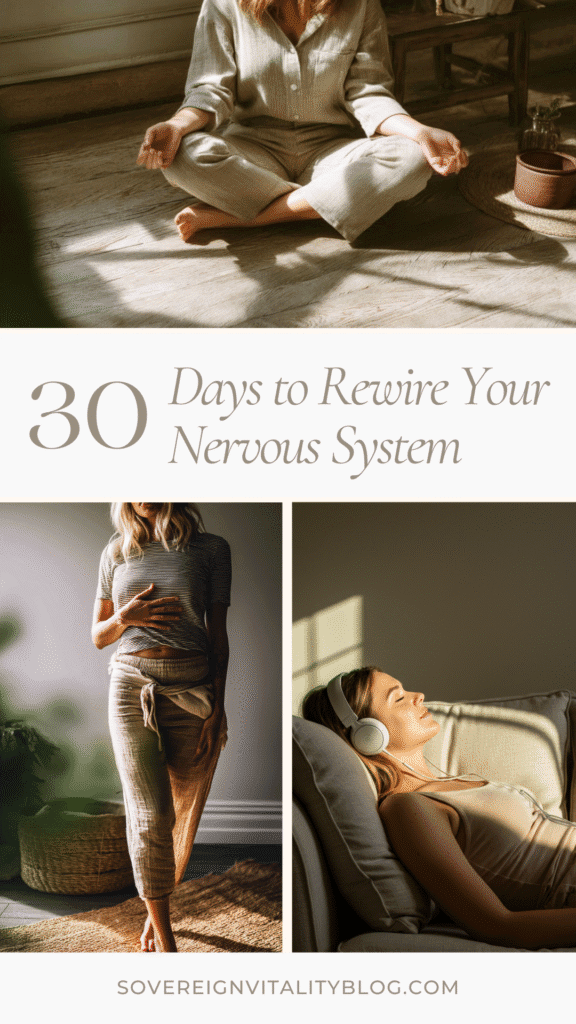This post may contain affiliate links, including those from Amazon Associates. If you make a purchase through these links, I may earn a commission at no additional cost to you. Learn more about our affiliate policy.
If you’ve been feeling wired, tired, irritable, and emotionally reactive – like your body is stuck in a permanent state of fight-or-flight – I want you to know that you’re not alone.
I’ve been right there too, caught in a cycle of stress and overwhelm without understanding why my body couldn’t relax.
It is so important for you to understand this: It’s not your fault.
Your nervous system is simply doing exactly what it was designed to do, protect you from perceived threats. But the problem is, when stress and overwhelm become chronic, your body never receives the message that it’s safe to unwind and rest.
Instead, it stays locked in survival mode.

I created this gentle and approachable 30-day plan for women exactly like you, who need simplicity and softness instead of strict rules.
I don’t believe in rigid routines; I believe in rhythmic practices that follow your natural energy.
So, rather than handing you a list of overwhelming tasks, this path helps you slowly rebuild trust with your nervous system, one gentle, reassuring step at a time.
(If you’re unsure if this is you, I invite you to explore these 7 Subtle Signs Your Nervous System Is Overstimulated.
Week 1: Regulate Your Daily Rhythm

When I first started learning about the nervous system, I was amazed to discover something magic called neuroplasticity.
It simply means our nervous systems can change and adapt based on consistent experiences. The more your body experiences calm and safety, it establishes a this as a baseline and more easily returns there naturally.
In this first week, your only goal is to gently signal to your nervous system that you’re safe, even just once each day. This is about incorporating just one small, intentional act of reassurance.
Below are a few simple yet powerful practices that I rely on regularly:
- Vagus Nerve Activation: I like gently massaging the outside edges of my ears, humming softly to myself, or splashing cool water on my face. These actions directly communicate with your vagus nerve, the nerve responsible for shifting your body out of fight-or-flight and into rest-and-digest.
- Breathwork: My go-to techniques are box breathing (inhale for 4, hold for 4, exhale for 4, hold for 4) or the 4-7-8 breath (inhale for 4 seconds, hold for 7, exhale slowly for 8). Both of these methods quickly calm an overstimulated nervous system.
- Somatic Grounding: When anxiety hits, I pause and place my hands firmly yet gently on my chest and belly, or simply stand barefoot on the ground. Legs-up-the-wall pose is another favorite; it gently signals safety and slows racing thoughts.
- Nature Immersion: Sometimes I simply step outside barefoot, touch a tree, or notice the warmth of sunlight on my skin. Even one minute outside can help ground your body back into a feeling of safety.
- Deep Imagining (DI): One of my most cherished tools is a Deep Imagning, a guided subconscious meditation from To Be Magnetic. I highly recommend their free Safe DI. These are especially supportive if your mind is stuck in looping thoughts or if your emotions feel activated. (If you choose a pathway membership, use my code SOVEREIGN for 15% off.)
Remember, these practices are not tasks to accomplish, they’re gentle invitations back into your body.
You only need five or ten minutes a day to notice a difference.
Trust that each moment of calm adds up.
Week 2: Create Your Weekly Reset Ritual

After a week of simple daily reassurance, you can introduce a slightly deeper practice: a weekly reset ritual. Think of this as your weekly exhale, a way to gently clear out accumulated stress and remind your body that it’s safe to relax.
Pick just one of these practices and anchor it into your week:
- Digital Detox Morning: Spending one morning completely away from screens feels like a mini-vacation for my nervous system. It reduces digital overstimulation, giving space for clarity and creativity to return. If this resonates, read my full guide on How to Create a 7-Day Digital Detox Plan That Calms Your Nervous System
- Restorative Movement Day: I love choosing one day each week to focus on slow, restorative movement like gentle yoga, stretching, or somatic dance. This helps release physical and emotional tension stored in my muscles, inviting relaxation and ease back into my body.
- Sunday Sanctuary Reset: Setting aside intentional space on Sundays for reflection, calm, and personal nourishment has profoundly impacted my nervous system health. It’s my favorite ritual for emotional regulation and energetic clarity.
- Self-Compassion Journaling: Sometimes the most healing practice is to gently write out what I most need to hear, or listen to a soothing guided meditation. This kind of compassionate presence deeply reassures the nervous system that it’s safe to be vulnerable and rest.
Pick the weekly ritual that speaks to you most clearly and feels most nourishing.
Notice how your body responds, and allow yourself to adjust gently as you go.
Weeks 3–4: Build a Supportive Lifestyle

In these final two weeks, you’ll gently layer in small, supportive lifestyle changes. You’re not drastically altering your life; instead, you’re creating small shifts that help reduce ongoing stimulation and invite consistent calm.
Here are a few simple lifestyle swaps I personally love and encourage you to try:
- Soft Lighting: Bright artificial lights stimulate stress hormones. Try dimming lights in the evening, or using candles or himalayan salt lamps to ease your nervous system into relaxation.
- Sensory Calm: Replace loud, overstimulating input with intentional silence or gentle instrumental music, particularly in the mornings and evenings.
- Soothing Scents: Essential oils like lavender, chamomile, and cedarwood help calm the nervous system. Try diffusing these in your living space or placing a drop on your pillow. Here are some of my favorite essential oil diffuser recipes.
- Digital Boundaries: Small boundaries around your screen time (grayscale mode, a nightly phone curfew, turning off notifications) greatly reduce subconscious stress.
You don’t need to adopt all of these at once. Choose one or two that feel accessible and comforting, and notice how your nervous system responds.
What to Expect (and Release)
Throughout this process, it’s important to know what’s normal.
Feeling emotional, restless, or resistant at times is completely natural. You might even skip days or feel unsure, and that’s okay. The magic is in gently coming back to your chosen practice again and again.
Your body has been holding onto stress for a long time. Each gentle practice sends your nervous system a message of safety, and eventually, your body will trust and believe it.
Conclusion: Calm Is a Skill, Not a Trait
What I’ve learned, and what I most want you to understand, is that calm isn’t something you’re simply born with. It’s a gentle rhythm you can always return to, no matter how overwhelmed you’ve felt.
One small exhale at a time, you’re remembering your way back to yourself. Bookmark or revisit this guide anytime you need a reminder. Gentle consistency creates profound and lasting shifts.



